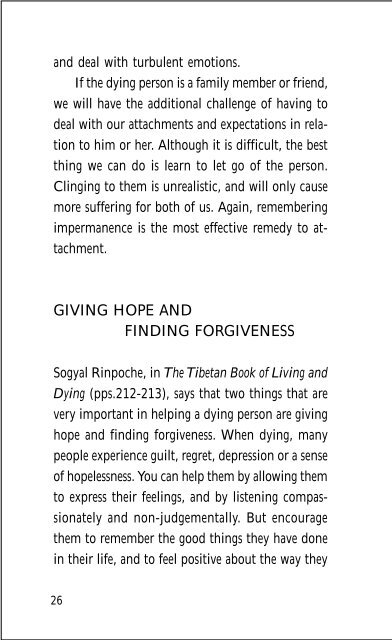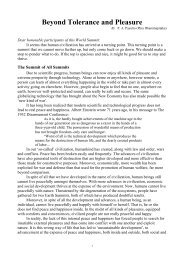Preparing for Death and Helping the Dying
Create successful ePaper yourself
Turn your PDF publications into a flip-book with our unique Google optimized e-Paper software.
<strong>and</strong> deal with turbulent emotions.<br />
If <strong>the</strong> dying person is a family member or friend,<br />
we will have <strong>the</strong> additional challenge of having to<br />
deal with our attachments <strong>and</strong> expectations in relation<br />
to him or her. Although it is difficult, <strong>the</strong> best<br />
thing we can do is learn to let go of <strong>the</strong> person.<br />
Clinging to <strong>the</strong>m is unrealistic, <strong>and</strong> will only cause<br />
more suffering <strong>for</strong> both of us. Again, remembering<br />
impermanence is <strong>the</strong> most effective remedy to attachment.<br />
GIVING HOPE AND<br />
FINDING FORGIVENESS<br />
Sogyal Rinpoche, in The Tibetan Book of Living <strong>and</strong><br />
<strong>Dying</strong> (pps.212-213), says that two things that are<br />
very important in helping a dying person are giving<br />
hope <strong>and</strong> finding <strong>for</strong>giveness. When dying, many<br />
people experience guilt, regret, depression or a sense<br />
of hopelessness. You can help <strong>the</strong>m by allowing <strong>the</strong>m<br />
to express <strong>the</strong>ir feelings, <strong>and</strong> by listening compassionately<br />
<strong>and</strong> non-judgementally. But encourage<br />
<strong>the</strong>m to remember <strong>the</strong> good things <strong>the</strong>y have done<br />
in <strong>the</strong>ir life, <strong>and</strong> to feel positive about <strong>the</strong> way <strong>the</strong>y<br />
26

















